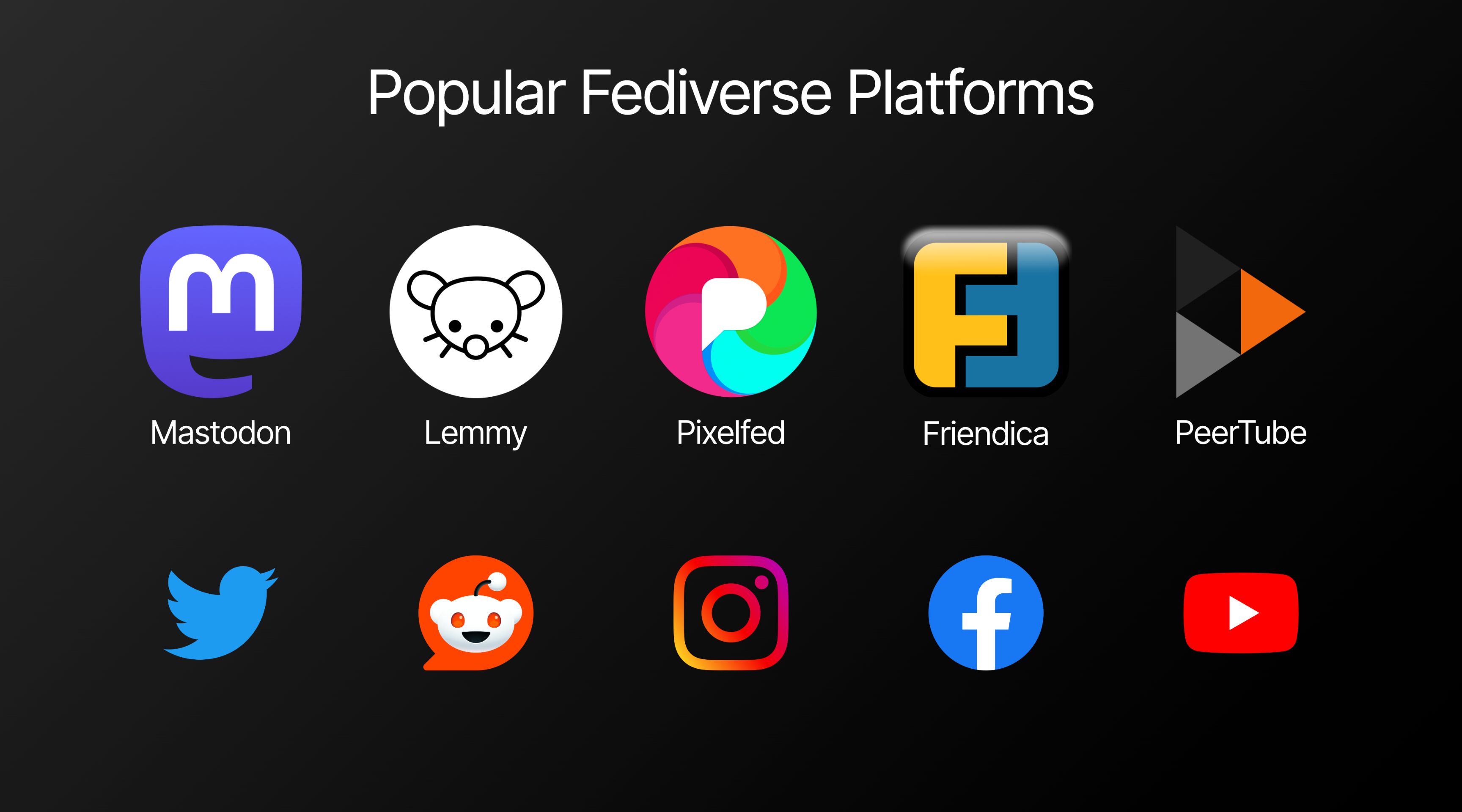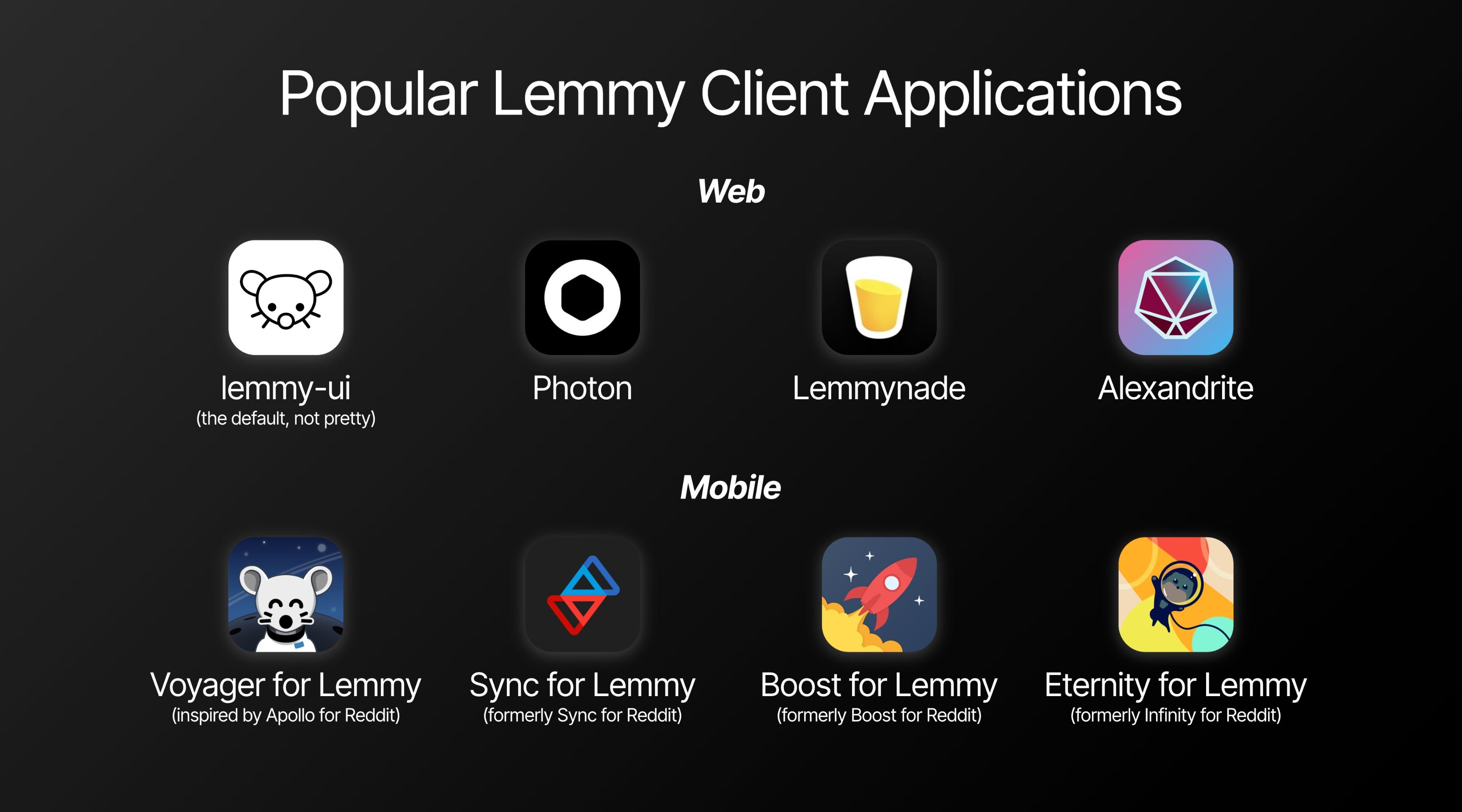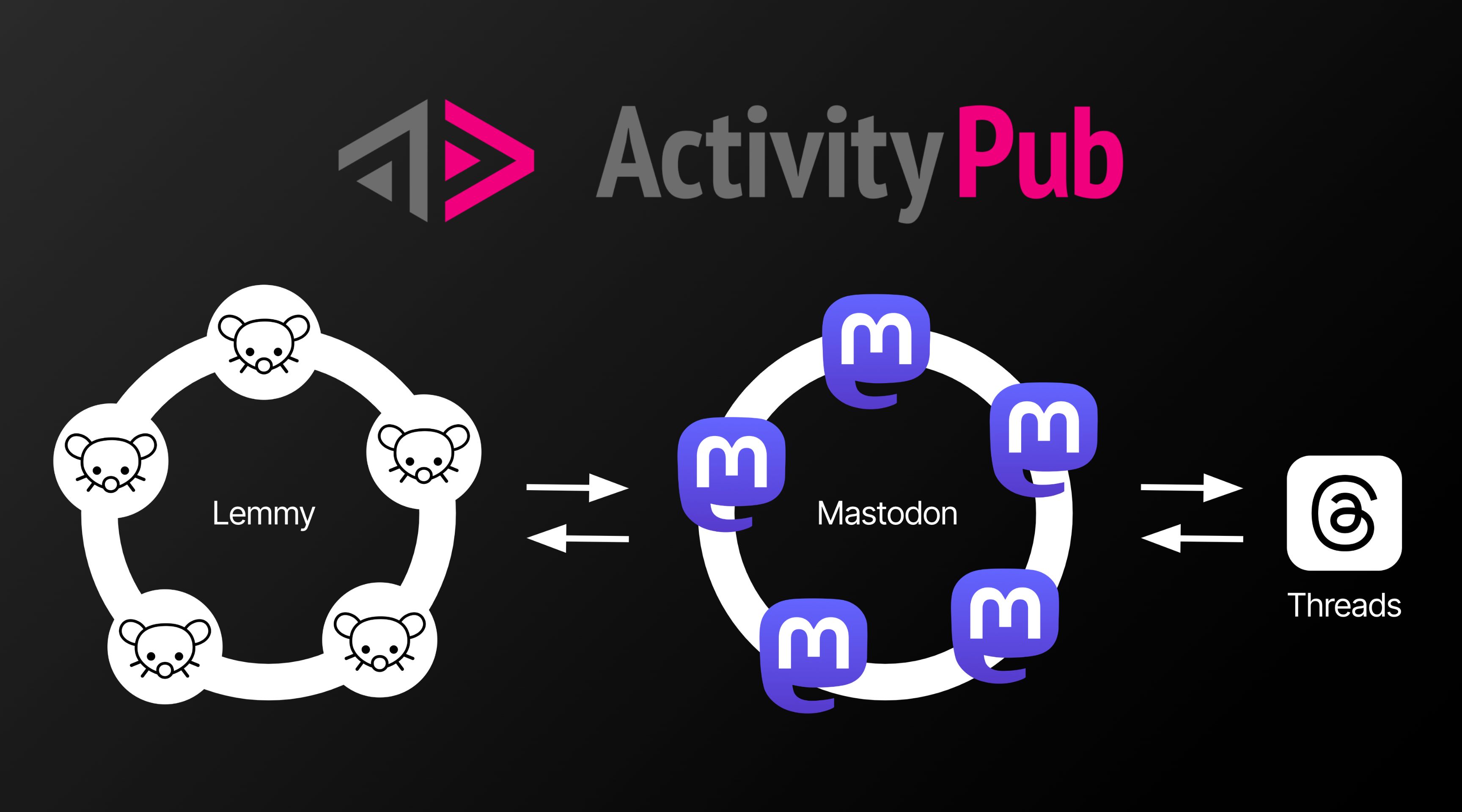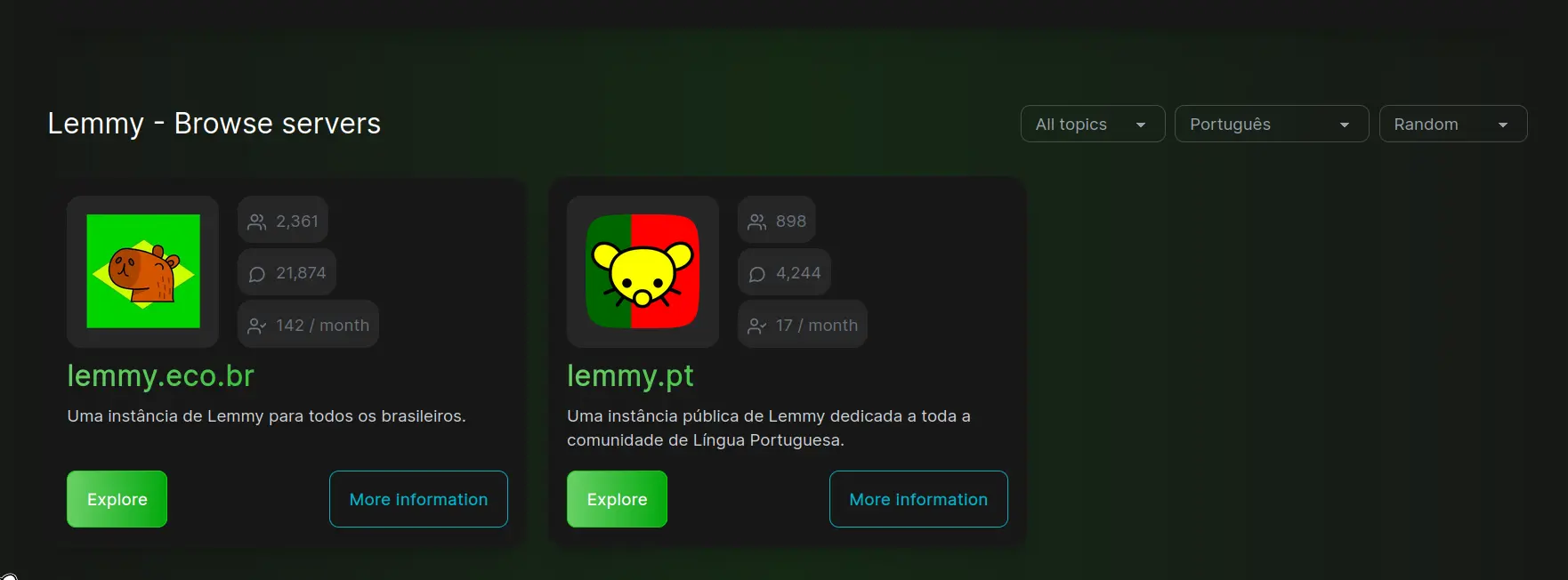Writing an article on the Fediverse and Lemmy in particular. What are your thoughts?
Decentralized Social Media: An Introduction to the Fediverse
I’ve always wished that, in some ways, messengers and social media would be more like email: You chose who hosts your inbox (Google, Microsoft, good old GMX/WEB.DE, more specialized providers such as Proton, …)—or, if you feel truly adventurous and trust no one, you can even run your own mail server in your basement. And regardless of your backend choice, you can pair it with whichever client application works best for you (the stock iOS Mail app on your iPhone, the Gmail web interface in the browser, Outlook on your desktop PC, …). And the beauty is: no matter what each one of us opts for, we can all stay connected and seamlessly send emails to each other across providers and client applications—thanks to widely-adopted standardized open protocols.

Now, imagine if social media worked the same way. Currently, most mainstream messengers and social media platforms are walled gardens, that lock their users into a closed ecosystem. But as some of these platforms like Twitter and Reddit have evolved (or deteriorated), some users found themselves seeking alternatives that offer this kind of freedom and choice.
Enter the Fediverse, a collection of decentralized social media platforms built on the principles of openness and user control. This post will introduce you to the Fediverse, focusing on Lemmy—a decentralized Reddit alternative—and explore the benefits and challenges they bring to the social media landscape.
What is the Fediverse?
The Fediverse is a collection of interconnected but independent social media platforms that communicate via open protocols. Unlike traditional social networks, which are centralized and owned by companies, the Fediverse is decentralized, meaning no single entity controls it. Instead, anyone can host their own server (called an “instance”) and connect it to the wider network.
Platforms within the Fediverse cover different use cases. By far the most popular platform is Mastodon (an alternative to Twitter) with currently over 7 million registered accounts and 800,000 monthly active users. In second place is Lemmy (a Reddit alternative) with a smaller but still significant number of around 400,000 registered accounts and 40,000 MAUs. Other less popular Fediverse alternatives include Pixelfed (Instagram), PeerTube (YouTube) and Friendica (Facebook).

The Rise of Lemmy and Mastodon
While over the course of time many platforms have been pitched as alternatives to mainstream social media platforms, few have gained lasting traction. Two platforms in the Fediverse, however, seem to have reached a critical mass of users that gives them a real chance of long-term relevance: Mastodon and Lemmy. Their growth can be attributed to user dissatisfaction with mainstream platforms.
Mastodon
Mastodon offers a decentralized alternative to Twitter. Its rapid growth coincided with Elon Musk’s controversial takeover of Twitter, which led to the reactivation of previously banned accounts, reductions in content moderation, and spikes in hate speech and misinformation. As these issues escalated, advertisers pulled out, and the platform’s value plummeted. Users flocked to Mastodon, seeking a less toxic, more user-centric environment.
Lemmy
Lemmy serves as a decentralized Reddit alternative. Its appeal grew after Reddit imposed high API fees on third-party developers, effectively forcing popular third-party client applications offline. While it is reasonable for Reddit, as the operator of the backend infrastructure, to seek a share of the revenue generated by these apps—most of which displayed ads and offered premium subscriptions—the proposed fees were excessively high. This move was widely seen as a shift of Reddit toward prioritizing its own ad revenue over its user experience. Lemmy, with its openness, community-driven ethos, and no API restrictions, became a refuge for those seeking to preserve the Reddit experience.
Getting Started with Lemmy
To truly understand the Fediverse, I’d recommend to dive in and experience it for yourself! Getting started with Lemmy is easy:
The first step is to choose an instance. An instance is a server that hosts the Lemmy software and that federates with other instances in the Lemmy network. You can check out join-lemmy.org that provides a directory of active Lemmy instances, including each instance’s focus and user count, helping you find one that suits your interests. Don’t overthink your choice—remember that you can still interact with communities and content from all other instances and communities, no matter which one you choose as your home.

Once you’ve selected an instance and registered an account there, you can start exploring the different communities on your home instance and on other instances. Communities are spaces where users share content on specific topics, similar to subreddits on Reddit. You can join as many communities as you like, engage with posts, comment, and contribute your own content.
On most instances by default you’ll encounter the default lemmy-ui web client. While functional, this interface is not particularly visually appealing—don’t let that overwhelm you. Once you’ve registered your account, I suggest exploring alternative client applications that better suit your preferences. There are various options available, including web clients and native mobile apps. Some of the mobile clients have previously been third-party Reddit clients, but pivoted to Lemmy as their new backend after Reddit imposed the aforementioned API fees.

The Technology Behind the Fediverse
The Fediverse is powered by ActivityPub, an open protocol that allows the different instances of a platform to communicate with each other and exchange its contents (“federation”). It can also facilitate connections between different Fediverse platforms and other platforms outside the Fediverse, provided their functionalities are compatible (for instance, interconnecting Lemmy and Mastodon is less practical because, among other functional differences, Lemmy is built around the concept of communities, whereas Mastodon focuses on individual users).

Here’s a simplified explanation of how ActivityPub works:
Naive Approaches
One option for decentralization would be for every instance to maintain a complete copy of all data, but this would be inefficient (this is what blockchain does, btw). Another option would be to retrieve foreign content on-the-fly only when requested, but this would make certain functionalities, like search, cumbersome.
ActivityPub’s Solution
ActivityPub strikes a balance by allowing servers to communicate and share content more intelligently. Servers exchange data when users from different instances interact, allowing for an efficient, distributed experience.
Integrity and Defederation
To ensure data integrity, the Fediverse relies on cryptographic keys and signatures. Each instance can also block other instances (defederation), giving users some protection against spam or malicious actors.
The Advantages of the Fediverse
The Fediverse offers a few clear advantages over centralized social media platforms:
Interoperability
Instances of Fediverse platforms communicate with each other, allowing users from one instance to follow and seamlessly interact with users on other instances.
Openness and Choice
Users can freely choose what instance to use, without missing out on the content of other instances. If you don’t like or trust any of the existing instances, you can even host your own instance. Furthermore, due to the open nature of the platforms, there are many client applications / frontends to choose from, for both, web and mobile. And also here you are free to start building your own client.
No “Concentration of Power”
Due to its decentralized nature, no single company controls the network, reducing the risks of data exploitation, censorship, or the negative effects of corporate takeovers.
Challenges Facing the Fediverse
Despite its promises, the Fediverse faces several challenges:
One-man Shows and Unstable Software
Most instances as well as client applications are run by individuals or small groups. If they lose interest or funding, their projects are vulnerable to outages or sudden discontinuation. Furthermore, Platforms like Lemmy are still in early stages (version 0.x), making them prone to unexpected bugs and stability issues.
Deletion of Content
Content removal is less straightforward than on centralized platforms. Once content spreads across instances, reliably enforcing its deletion from all places becomes difficult.
Monetization
The operating cost of the instances are largely funded by donations and the efforts of enthusiast developers, which is a model that often lacks long-term viability. While some client applications show ads to their users and offer paid premium subscriptions, this primarily benefits the app developers rather than the server operators, who carry the much more significant burden in terms of infrastructure costs. This needs to be solved, possibly with a revenue-sharing model, to avoid a repetition of what happened between Reddit and its third-party app developers.
Decentralization Slows Innovation
In decentralized ecosystems, introducing new features or updates can be a slower process because decentralized protocols like ActivityPub require broader consensus for changes and must maintain backward compatibility. Centralized platforms, by contrast, can move faster since they control the entire protocol and user base.
“Outcompete and Isolate” Threat
Meta’s Threads, a centralized platform, has recently started to federate with the Mastodon network, which raises strategic concerns. They might use their substantial resources to offer a more polished experience over the same content, potentially attracting users away from independent Mastodon instances and client applications. If Threads were to later limit or cut off their connection to the Fediverse, they could retain the users they gained, letting Mastodon hang out to dry. While this scenario might sound far-fetched, it is precisely what happened more than 10 years ago with Google Talk and the open instant messaging protocol XMPP.
Conclusion
In conclusion, while the Fediverse offers a promising alternative to traditional social media through its decentralized, interoperable, and open nature, significant challenges remain. Compared to the mainstream social media platforms, while not insignificant, the user numbers of platforms like Lemmy and Mastodon are still merely a drop in the bucket. Coupled with issues such as long-term financial sustainability, for which effective solutions have yet to be found, the future of the Fediverse may be uncertain.
However, recent regulatory changes like the EU Digital Markets Act (DMA) could shift the balance. For instance, WhatsApp is currently working on and rolling out a “third-party chats” feature, which is all about making WhatsApp interoperable with other different messaging services. This move, driven by regulatory pressure, signals that even major platforms might need to embrace more open and interconnected ecosystems—potentially opening the door for decentralized platforms like those in the Fediverse to gain more traction and user interest.
A brief mention of Mbin and Piefed might be nice, and possibly Mastodon alternatives like GoToSocial, Pleroma, and Misskey as well. It highlights that content is software independent, and is a bit more fair to some smaller but nevertheless impressive projects.
Since you’re asking for feedback:
Very good intro and analogy to email.
I’d delete the sentence with “focusing on Lemmy”, since you’re going ahead and talking about the Fediverse in general in the next sentence, and then Mastodon. And the article is more broad and not really focusing on Lemmy, one paragraph aside.
There are quite some good paragraphs. Explaining the concepts very well, and without the need for prior knowledge. You also mention protocols, give examples. I think it’s written very well and good to understand.
I’d add a bit more info on how federation works and the consequences. Earlier on in the text to clarify the terminology. That instances are the interconnected nodes that make up the network. In the background the information gets forwarded between them. Every instance can have it’s own rules and perspective on the network. Cater to specific interests or have a unique design.
The paragraph on “Openness and Choice” isn’t entirely correct. Users can miss out on posts. Not all posts are visible from all instances.
I’d add a paragraph that it’s made by the people, for the people. And not for some corporate interests.
I like you also mention the downsides. I think you should rename “Monitization” into “Funding”. And especially the “slow innovation” is some downside that might not be very obvious. It’s nice to mention that.
You could also mention the “network effect” because that’s also something we regularly struggle with.
And that this happens to be powered by Free Software. And we can choose which server software to use and everyone is invited to participate or change things to their liking.
That instances are the interconnected nodes that make up the network.
I would even just use the word “parts” instead of “nodes”.
Don’t overthink your choice—remember that you can still consume content from all other instances and communities, no matter which one you choose as your home.
I find the framing here very problematic. Both because passively “consuming content” is inherently problematic and because Lemmy just doesn’t have sufficient “content” to enable that, thus leading to quick disappointment of users looking for that kind of experience.
And in general it does matter with instance you chose. Not to the point that new users should worry too much about it, yes, but there are distinct cultures between different instances and it is a strength of the Fediverse that instances are not just faceless pieces of infrastructure, i.e. pipes to content, but rather thriving communities with real people behind them.
I certainly wouldn’t want new users to randomly end up on .ml because they think it doesn’t matter.
Rereading the whole text again, I agree that it should probably be modified.
@WhimsicalWave@lemmy.world, I usually point out to lemm.ee, because
- second largest instance of Lemmy per monthly active user
- not experiencing the issues that LW has with geographically distant instances: https://lemmy.world/post/20575394
- very short defederation list: https://lemm.ee/instances (3 instances)
- neutral name (compared to sh.itjust.works)
- non-interest or country related
You could maybe suggest to go to Lemm.ee if they don’t want to bother with choice, and then keep your existing paragraph about join-lemmy.org if they want to have a deeper look.
From past experiences, the instance choices is a very strong factor with people not giving Lemmy a try, because it’s confusing. Most of the people just want one URL to go to, and that’s it. If they want to move later, we now have settings export and import, so it would be easy. But having them try the thing is the biggest challenge here, and not providing them a default suggestion might hinder that.
I actually personally wouldn’t recommend it for new users specifically because of the third one.
I know that lots of ‘freeze peach’ trolls love to complain about defederation. The thing is though the majority of the defederations are actually beneficial to new users who may be scared or unnerved by some of the shit that comes out of those blocked instances.
I think that it’s important for us to recognize that the stigma against defederation, is largely because of trolls who have to resort to sign ups on our servers to spread their messages here. There really aren’t a lot of arbitrary defederations, it’s mostly hate speech in spam. The stigma doesn’t really have the merit that it might seem.
Additionally I would also not really recommend lemm.ee, for brand new users, on the count of their very loose moderation policy instance wide. Since that can create some scary and unpleasant situations that may be unnerving to normies.
Another reason is that the image upload size is, unreasonably tiny on lemm.ee, and they limit your ability to do uploads for a long time. Something that will likely be very annoying to people who sign up there since they won’t be able to set up their account with a picture, and even when they can it will be ridiculously tiny. It can be really annoying, especially to new users when things don’t just work.
Probably why, among other reasons, the idea of naming an instance
shit just works, was even a thing. And even though you don’t like it because of the name I would still recommend it because they have insanely good and insanely effective moderation. Despite being one of the few instances that doesn’t ask people to beg or play 20 questions on signup.Hi, there is no free speech policy on lemm.ee, we have very strict moderation when it comes to our rules. We regularly permaban users for breaking our instance rules. We simply don’t use defederation as a moderation tool, preferring other tools like user bans, for reasons outlined here: https://lemm.ee/post/35472386
Sorry if I caused confusion, when I said “freeze peach trolls” I didn’t necessarily mean that lemm.ee was a free speech instance or that I thought it was. I was more so talking about the people who complain about defederation in comment sections on Lemmy and on Reddit, and how most of them are bellyaching and upset that objectionable content and servers are censored.
I’m glad to hear that there is a strict moderation policy over on lemm.ee, even if you don’t use defederation as part of moderation.
About the picture upload, do you think it would be possible to allow new users to set up a picture immediately, and increase the limit a bit?
Thank you for clarifying!
Fair points.
About the name, I still got quite a few reactions that told me there was no way they were going to browse daily a site with shit in the name.
What do you think about Lemmy.zip?
I’m not really sure about lemmy.zip. I’ve browsed it a little bit in the past and it seems like an okay instance. It does have a pretty short block list which, also could pose issues for new users should they stumble into hexbear or grad folks.
However the biggest problem I’ve faced is that since it’s a .zip domain and my ISP seems to be doing something funny with them, I can’t actually connect with the server unless I’m on cellular, a VPN, or Tor.
I’ve tried changing DNS settings and even setting up DoH but it doesn’t really seem to be helping. It only connects to the site when I’m not on my home network, or on a VPN or Tor. It’s possible that my scenario might be an edge case, and other isps may not actually be blocking zip domains. Though if it is happening with others, that could be a really frustrating problem for somebody facing it since the solution isn’t obvious (it just looks like there’s no connection).
There may be other problems with the instance that I haven’t considered, like Federation issues or culture. The biggest and most glaring problem though is the connectivity issue, which probably isn’t universal, but has severely limited me from checking them out.
Interesting.
I opened that thread on a local community a few weeks ago to discuss that topic, only one other person had an issue (work firewall was blocking it): https://lemmy.zip/post/23138027
What I like about lemmy.zip is their regular very detailed reports: https://lemmy.zip/post/23138027
I guess it’s not really surprising given that back when zip domains were introduced there was a lot of concern about them being used for phishing.
(I typed this out but forgot to hit send).
That inability to passively keep “consuming content” is honestly a big strength of Lemmy for me. On Reddit I can sometimes get sucked in for hours on end, and I can get mentally exhausted pretty quickly but just keep scrolling for “the next thing.” The fact that you can’t really do that on Lemmy has made it a much healthier choice for me to spend time here, and I’ve only just started (kinda – it’s complicated).
Interactions here feel so much more personal too, which I like. Even with all the various instances and communities, we’re also all part of the same community. And that can kinda extend to the fediverse as a whole too. What we have in common is that we all want an alternative to the corporate social media landscape that gives more freedom to the users, and enables interchange between platforms to discourage monopolizing walled gardens. It really is fantastic.
there are distinct cultures between different instances and it is a strength of the Fediverse that instances are not just faceless pieces of infrastructure, i.e. pipes to content, but rather thriving communities with real people behind them.
Yeah, that deserves emphasis.
There’s tons of content to consume here. Just browse all.
Especially when you factor in which instances are defederated from others
I don’t think it’s anywhere near as big of an issue as people try and make it out to be. Most of the widely defenerated instances are spam and trolls. There are a couple of legit ones from feudes, but for the most part going for a low-defederation or no-defederation instance is probably more trouble than it is a benefit.
Since it’ll expose those new users to things that might very well scare them away.
I usually point out to Lemm.ee, which has a very small defederation list (only 3 servers defederated: https://lemm.ee/instances)
I skimmed through it, looks good
If you want to have additional ideas, I wrote that short post a few weeks ago to address common criticism against Lemmy: https://old.reddit.com/r/RedditAlternatives/comments/1fmuk7o/post_to_address_the_usual_criticism_about_lemmy/
Overall I think this is well written. I agree with @poVoq@slrpnk.net that the section on picking an instance could be improved, since which instance one picks can be rather important, since federation/defederation is dictated by individual instances.
And a minor typo I noticed:
leaving Mastodon out to try
I assume that should be “out to dry”.
It’s pretty good, but I think it should be explained a little more about the selection of instances. I understand that for basic users what you put may be worth it, but such a long text I don’t think it is for basic users and for those who want to know a little more to explain that they must take into account moderation policies and federated/defederated instances I don’t think it is going to lengthen it too much over what you have now
Quick question. As Lemmy grows with more post and comments won’t it becomes more and more expensive to host for everyone, even small instances?
https://feddit.org/post/2600584
On top of that, we still seem to have a wide margin, especially for text-based posts and comments.
For pictures and videos, external hosting such as https://catbox.moe/ can help to ease the load on the instances.
Interesting I really thought it’d be more… I wanna make one now hahaha
Ayyy I love catbox! I found out about it from someone’s comment here on Lemmy and have been using it ever since
or this post I just did:
Well, while we don’t overthrow the system, we still can use its infrastructure to subvert it, and that applies here on the internet as well.
Today I’m going to teach you how to get the URL of videos from Reddit with audio and images.
You can press the
F12key, this will open DevTools, and go to theconsoletab. Then paste this code:let array = document.getElementsByTagName("shreddit-player")[0].__packagedMedia.playbackMp4s.permutations; let url = array[array.length - 1].source.url; alert(url);If you want to create a shortcut to make things easier, just make a bookmark and paste this here in the address field:
javascript: let array = document.getElementsByTagName("shreddit-player")[0].__packagedMedia.playbackMp4s.permutations; let url = array[array.length - 1].source.url; alert(url);This code opens an alert with the video’s URL for you to copy and use wherever you want.
Like this:

Interesting, thanks!
Probably worth to crosspost your post to !reddit@lemmy.world
The original I did in Portuguese, I will post it there now :)
This is great! Thanks!
Interesting comments there. Thanks for the pointer!
You are welcome!
Just wanted to applaud the fact that you’ve come here asking people, rather than asking some large language model.
leaving Mastodon out to try
While it’s clear what’s meant from the context, I’ve never heard this idiom. Do you mean “hanging Mastodon out to dry”?
Drop in the bucket sounds weird to me too, but a quick check shows that it’s the US version of drop in the ocean.
Good point, fixed, thanks!
Add Brasil to the country specific too, come on! (jk)
Great text, very complete, when you publish let me know and I will add a translation to our instance and to Brasil subreddit.
Ah yes, seems like I missed that, now added 🇧🇷 (and a few more countries as well)
Cool, thanks!
You can definitely add your instance for Brazil by opening a pull request on https://github.com/LemmyNet/joinlemmy-site
Hey :)
We are already there

I was referring to the text above.
Ah, indeed!
@WhimsicalWave@lemmy.world, could you please also add https://jlai.lu for French speakers?
Good point, added 🇫🇷 (and a few more country-specific instances)
Thank you!
When i first heard of it i though fuck thats cool a federated account. But no apparently not, definatly think its what will take the fediverse into the mainstream. Technically its doable if everyone keeps their private key then u dont need to trust the instance. Does anyone know if this is possible with passkeys?
Hubzilla does what you want.
Streams too, it’s called “Nomadic Identity” there on the Fediverse
Have you had a look at ActivityPods?
Maybe not the perfect place to ask, but under topic specific instances, mander is highlighted. What topic is this?
Science: https://mander.xyz/
I guess I should have been more specific, I apologize. What is the relation to the word “mander” and the topic of the instance?
It’s a pun. The admin name is @sal@mander.xyz, so “Salamander”
That’s pretty smart. Guess what I will buy redacted domain(I don’t want bot to buy it).
I know domain hack exist. I just like @ b/w sal and mander.

















